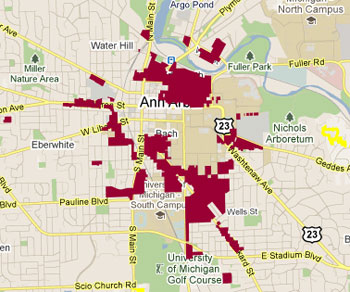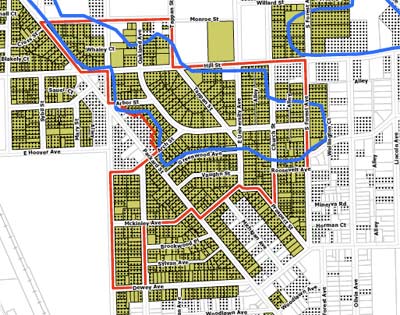R4C Draft Readied for Planning Commission
Changes to parking requirements, lot combinations, and creation of a possible new “group housing” zoning district are among the draft recommendations that have been presented to Ann Arbor planning commissioners for the city’s R4c/R2A zoning districts. It’s a project that’s been years in the works. [.pdf of staff memo and proposed R4C/R2A draft recommendations]

The dark red areas are those locations that are zoned R4C in the city of Ann Arbor. (Image links to Google Map)
An April 9, 2013 working session was a first chance for all commissioners to have a look at the recommendations, which will be formally presented at the commission’s April 16 regular meeting.
The commission’s ordinance revisions committee (ORC) has been working on draft recommendations since the summer of 2012. The committee’s work follows a report delivered in May 2012 by an R4C/R2A zoning district study advisory committee that had worked on the issue since December 2009. [.pdf of advisory committee report.
For more background on the issues leading up to this current study – which dates back several decades – see Chronicle coverage: "Planning Group Weighs R4C/R2A Report" and "Effort to Overhaul R4C Zoning Continues"]
R4C zoning allows for multiple-family residential dwellings, such as apartment buildings. R2A zoning limits density to two-family residential structures. Although both types of zoning are being addressed, R4C zoning is receiving the most attention. That type of zoning classification – which allowed for the controversial City Place development on South Fifth Avenue – has been characterized by city planners as “broken.” The advisory committee’s work had focused on preserving the character of existing neighborhoods, in part by preventing current structures from being demolished and replaced with larger buildings.
The current draft recommendations propose implementing changes in two phases. The first phase primarily includes changes that were recommended by the advisory committee, with some modifications made by the ORC. [.pdf of chart comparing existing code, advisory committee recommendations, and ORC recommendations]
For example, the ORC is recommending parking requirements that less stringent than either the existing requirement of 1.5 spaces per unit or the advisory committee recommendations (1.5 spaces per unit for 0-4 bedroom units, and 2 spaces per unit for 5-6 bedrooms). The ORC parking recommendation is for 1 space per unit for 0-4 bedrooms, and 1.5 spaces per unit for 5-6 bedrooms.
In addition, the ORC is recommending these changes for the first phase:
- Lot combinations need approval: Planning commission approval would be required for lot combinations in R4C districts, as part of a project’s site plan review. Review standards would be developed, as well as standards for design and massing, to ensure that new development is compatible with the neighborhood. [The advisory commission had recommended instituting a maximum lot size of 6,525 square feet, equal to an allowable density of three units. The ORC consensus was that this maximum lot size would be too restrictive.]
- Conflicting land use buffer for vehicle areas only: The only areas that would require screening would be those used for vehicles – such as areas used for parking. This recommendation essentially reverts to the requirements used prior to 2011, when the city instituted changes to its landscape ordinance. Those changes expanded the conflicting land use buffer requirement in R4C districts to apply to the screening of buildings, in addition to vehicular use areas. The change resulted in an increase in variance requests for redevelopment in R4C districts, given the small size of the lots. [The issue was not part of the advisory committee's recommendations.]
- Further study of R2A district: Further study is called for to determine if the R2A lot size should be reduced to 6,000 square feet, allowing opportunities for duplex conversions. This number is based on the lot size requirement that was in place prior to 1984, when the requirement was raised to 8,500 square feet. [The advisory committee did not recommend zoning changes in the R2A district.]
Based on discussions among staff and the ORC at previous meetings attended by The Chronicle, these first-phase recommendations are seen as somewhat easier to implement, because there is general consensus on them.
A second phase would focus on creating a “group housing” zoning district. The advisory committee had recommended preserving the character of existing R4C neighborhoods by creating overlay districts on a neighborhood-by-neighborhood basis, with standards for massing, design and patterns of development. Instead of that approach, ORC has recommended designating a new zoning district, located south and west of the University of Michigan’s central campus – an area outlined in the city’s Central Area Plan. [.pdf of Central Area Plan]

Map showing proposed group housing district, outlined in red. Roughly, the boundaries are State Street on the west, Dewey and McKinley on the south, Forest on the east, and Hill and Monroe on the north. The yellow-green areas indicate lots that are zoned R4C. The blue boundary is an earlier draft of a possible group housing district.
The intent is to address issues that are somewhat unique to neighborhoods with a large amount of student housing. In general, the approach would allow for flexibility through the use of limits on floor-area ratio (FAR) – with premiums provided in exchange for community benefits such as pedestrian-friendly and architectural design standards. For example, parking would be based on FAR, independent of the number of units in a structure. The ORC also recommends studying a payment-in-lieu-of-parking approach, similar to the policy in place for the downtown area.
About a dozen members of the public and from the R4C/R2A advisory committee attended the April 9 work session, as did city councilmember Mike Anglin (Ward 5). There were two opportunities for public commentary. Several members of the advisory committee expressed concerns about the proposed group housing district, as well as with other aspects of the recommendations related to parking, lot size, lot combinations and other elements.
The planning commission intends to hold a public hearing on these recommendations at its April 16, 2013 meeting. If approved, the recommendations would be forwarded to the city council for consideration. If the recommendations meet with approval from the city council, the planning staff would then work with the city attorney’s office to develop specific ordinance revisions to implement the recommendations. Those ordinance changes would also be reviewed by the planning commission’s ordinance revisions committee before being voted on again by the full planning commission and then the city council.
The Chronicle survives in part through regular voluntary subscriptions to support our coverage of publicly-funded entities like the city’s planning commission. If you’re already supporting The Chronicle, please encourage your friends, neighbors and coworkers to do the same. Click this link for details: Subscribe to The Chronicle.




The planning commission should accept the recommendations of the advisory board and set a maximum lot size with no lot combinations allowed that exceed that size. What’s the point of creating a whole new set of review standards (which, at this pace, could take another five years)? As I understand it, limiting the lot size would automatically control the size of proposed developments because each bedroom proposed would be tied to a minimum number of square feet of lot size (and individual dwelling unit size).
This planning commission has shown that it will gleefully approve lot combinations for very inappropriate developments in residential areas. But the people of this community have spoken loudly and often that they are tired of having to fight to keep large-scale developments out of residential-scale neighborhoods. If this planning commission wants to continue its quest to maximize population density in the D1 downtown district, then they need to send a message that it is not appropriate to allow large-scale developments to sprawl out into neighborhoods. To curb suburban sprawl, we need to be encouraging families, working people, and retirees to return to the neighborhoods within the city limits. These are the people who buy houses and condos and have the freedom to choose between a new house in the country or an existing neighborhood in the city.
Secondly, there needs to be a ban on any new dwelling units with more than four bedrooms outside of group housing zones (if those are indeed created). Five and six-bedroom units are built with only one purpose in mind: the housing of undergraduate students. We need to encourage diversity and flexibility in new construction, and one to four-bedroom units are flexible–especially one and two bedroom units. Unfortunately, the revisions to the R4C being recommended will actually put language into the zoning ordinance for the first time referring to five and six-bedroom dwelling units. We should not give these jumbo units this legitimacy.
Recent approvals of five and six-bedroom dwelling units have only been granted based on a very loose interpretation of the code that stipulates that in R4 areas, up to “six unrelated persons may share a housekeeping unit.” By the definitions in the zoning and housing ordinance, a housekeeping unit is NOT a dwelling unit, and in fact, six unrelated persons could share a three-bedroom dwelling unit, provided the rooms were sized appropriately. There’s nothing to dictate each occupant of a housekeeping unit having his or her own bedroom.
Five and six bedroom apartments–especially those where tenants are grouped with complete strangers, with separate leases and deadbolt locks on their bedrooms–are actually rooming houses by any common, ordinary definition. They are certainly not functioning as “housekeeping units” which are defined as such in order accommodate non-traditional families or groups of students who choose to share an old house together. The housing code defines a housekeeping unit as “A dwelling unit ORGANIZED AS A SINGLE ENTITY, IN WHICH MEMBERS OF THE HOUSEHOLD share common kitchen facilities, and HAVE ACCESS TO ALL PARTS OF THE UNIT.”
As with any new zoning provisions, existing buildings and houses are exempt as long as they continue to operate as they have been, so this would not affect the large, undivided houses currently being shared by students and others. It would only apply to new buildings or buildings that are substantially altered.
I agree with every point made by Tom Whitaker here and will add this–The zoning ordinance states that if a use (such as the pods of locked bedrooms) is not explicitly permitted in the ordinance, it is “prohibited”. Allowing this harmfully interpreted use violates our zoning ordinance.
Re: [2] “pods of locked bedrooms”
Alice, can you clarify what you mean by that?
Re (3) Dave, I think Alice is referring to the current practice of building student rental properties with 4 to 6 bedrooms, each lockable bedroom subject to an individual lease. Under this practice, the landlord rents each bedroom separately and a group of complete strangers can become the “household” merely because they share a kitchen and living room.
I completely agree with Tom’s desire for lot size restrictions and with Tom’s and Alice’s desire for restrictions on the number of bedrooms in an apartment.
If we should have learned anything from the complete failure of the A2D2 zoning changes it is that this kind of broad change will have many unintended consequences. Council failed to heed the warnings about the flaws in the A2D2, will they also fail to do the R4C correctly?
Amen to 1,2, and 4.
Time to re-visit German Town?
BTW, why not group housing on/around North Campus?
Seems only fair to hold up decisions until the new group housing party attains representation on council. [link]
Yes, I’m being snarky. “All this has happened before, and it will happen again.”